The jungle is an alluring and mysterious biome and one that instantly captivates all but the least curious with its cacophony of vocalisations, its mesmerising colours, and the sheer business of the biodiversity it houses, including some of the most iconic jungle animals.
And as alien as it might feel to most of us, the jungle is where we come from. It’s where we belong, to an extent, and it’s a home we have neglected to the point of almost total devastation.
Two-thirds of our tropical rainforests have been destroyed by our own hands, and half of what remains is in poor shape.
But instead of repairing it, we are cutting and burning 150 acres more every single minute, and while this loss is often measured in terms of losses in CO2 sequestering, or oxygen production, what’s often overlooked is that it’s also the destruction of the homes and lives of the inhabitants of these forests.
Here’s a shoutout to 20 such inhabitants; animals that still call the jungle their home, in no particular order, and with millions of glaring omissions simply because there are so many to choose from.
20. Tapir
There are four species of tapir, all closely related to horses and rhinoceroses as odd-toed ungulates.
There were once many more species, including several native the North America and Southeast Asia, that died out at the end of the Pleistocene, and the four that remain are slightly pig-like, semi-aquatic jungle mammals, living in Central and South America, and one species in Southeast Asia.
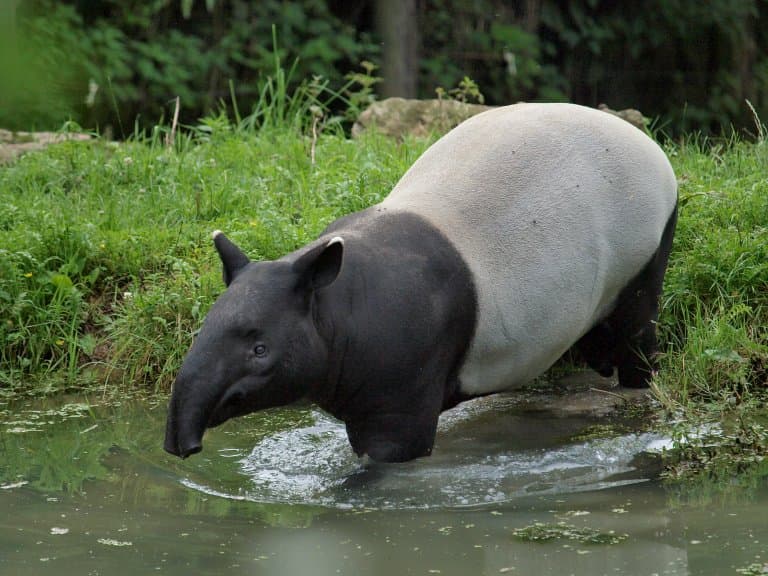
Tapirs are quite similar to pigs in their ecology, too. They spend a lot of time wallowing in mud and eat a lot of vegetation and fruit. They have extended rostrums, made of their nose and lower lips, giving them a bit of a bizarre appearance, but they’re generally shy and relaxed animals.
All four are listed as Endangered or Vulnerable by the IUCN as a result of habitat destruction and human encroachment. 1
19. Greater Capybara (Hydrochoerus hydrochaeris)
The largest rodent in the world lives in the jungle, too! Capybaras are widespread in South America, and like the tapir, they love wet environments.
These swamp specialists are excellent swimmers, able to hold their breath for five minutes, and one of the keys to their success is their adaptability to the conversion of forest into cattle ranching.
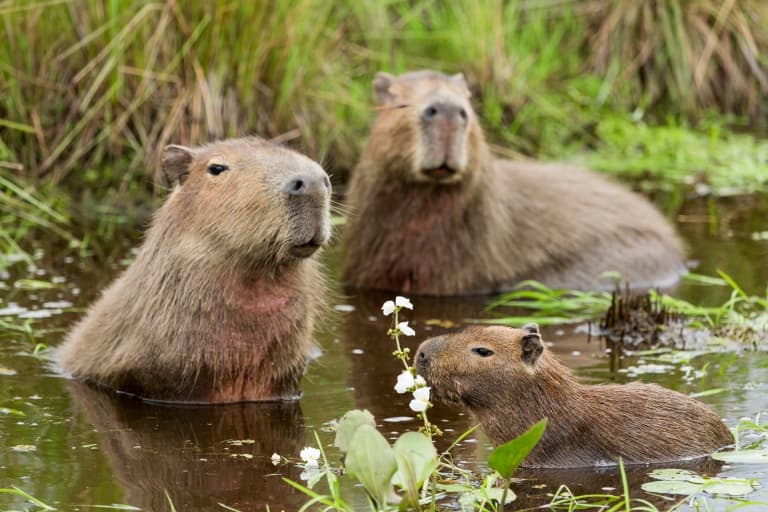
There was a period when these animals were kept in a research facility and interestingly, escapees from captivity have been thought to have established colonies in the very same niche their prehistoric relatives would have before they were hunted to extinction there.
This sort of inadvertent reintroduction can be seen in both Florida and California. 2
18. Green Anaconda (Eunectes murinus)
From scurrying to slithering, one of the most impressive animals in the jungle has to be the green anaconda.
It’s the biggest and heaviest snake on Earth (although not the longest!) and a giant boa constrictor that lives in the same forests as our first two animals. As such, this is a monster that they are likely to face at one time or another.

This snake can potentially reach up to 6.7 meters, or 22 ft long, and can weigh around 250 kg. This makes it one of the heaviest animals in the jungle, and certainly one of the strongest.
They can eat anything up to 50% of their own mass, and they kill by latching on with non-venomous fangs and securing their prey in their squeezing, meaty coils. The squeeze is so strong it prevents the heart from beating, and the prey loses consciousness fast.
Anacondas are mostly water-based, and if the prey animal is frisky enough to pose a risk to the snake, she’s more than capable of drowning them in the river.
17. Ocelot (Leopardus pardalis)
Some might consider this a shift from the scariest to the cutest, but if you’re a bird in the rainforests of Central and South America there is nothing cute about the ocelot.
These gorgeous, solitary killers stalk their prey in the night and spend much of their lives up in the trees. This not only keeps them safe from some of the larger predators around but also gives them access to unique feeding niches.
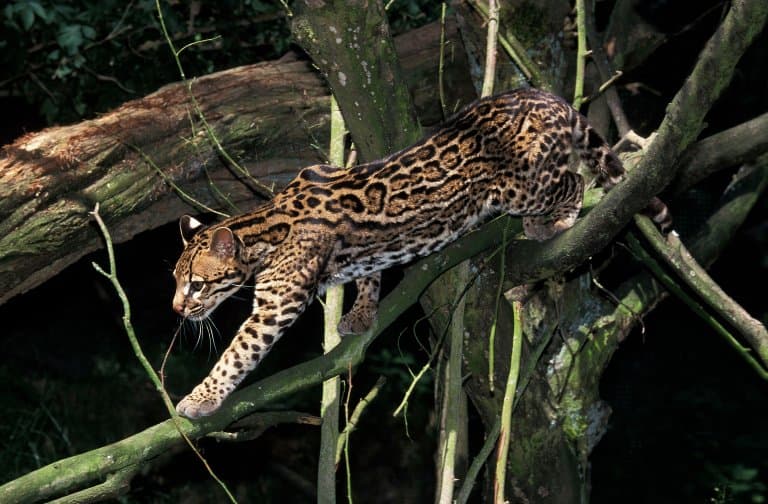
They can wait in ambush for up to an hour, stalking prey of all kinds, on land, in water and arboreally.
Their small size belies a powerful cat and a dominant mesopredator in their ecosystem.
Despite the name, the genus Leopardus contains small cats, all of which are native to the Americas (leopards are, confusingly, in the Panthera genus).
16. Macaws & Parakeets
Macaws are the birds many people think of when they hear the word parrot. These classically good-looking animals and one of the most iconic birds you can find.
Very large, intelligent and extremely brightly coloured, they can reach a meter tall and weigh over 1.5 kg. There are thought to be around 19 species, though some might now be extinct.

They can live for up to 80 years and in the wild they would be invaluable seed dispersers, feeding on fruit and nuts and helping plants spread their genes across the forest.
Being such beautiful birds, their numbers have dropped significantly as a result of the pet trade, but habitat loss and fragmentation continue to threaten all species. Many are either endangered or critically endangered, and bird collectors can pay thousands of dollars for a single specimen of some species. 3
15. Okapi (Okapia johnstoni)
Certainly one of the weirdest mammals in the jungle is the Okapi. These funny little fellas are essentially dwarf giraffes, standing at around 1.5 meters tall in the forests of Central Africa.
It’s said to have a long neck, but considering the rest of its family, this is pretty relative. The Okapi looks somewhere between a zebra (with its striped rear end) and a giraffe, with its ossicones, or bony protrusions, unique to the giraffe family.

All of this weirdness functions as excellent camouflage, and they’re thought to be primarily diurnal. Males are always on the move, and females tend to stay put, but in general, they are quite low-density populations, with just over one animal in every 2 km2.
They’re generalist herbivores and are known to leave a gross sticky goo on trees when rubbing on them, but due to their shyness and the fact that they live in DRC, we don’t know much about their mating routine.
Sadly, they’re already endangered, with the two major threats coming from snare hunting and habitat destruction.
14. Pangolin (Manidae family)
Pangolins are probably the most expensive mammals on the market and are certainly the most trafficked. People without the ability to google think their scales are magic, and so have driven this unique animal almost entirely to extinction.
Pangolins are the only scaled mammals, which is what led to this misinformation in the first place, and both groups – one found in Asia, the other in Sub-Saharan Africa – are persecuted as a result.
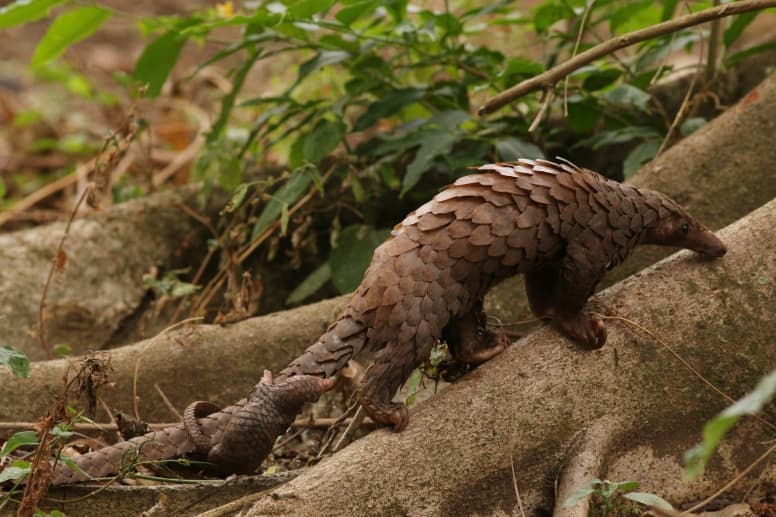
In reality, like all other animals, pangolins are not magic. They’re a small branch of nine species of anteaters who would much prefer to be left alone to feast on termites and ants all night.
Eight of the nine species are considered either Vulnerable, Endangered, or Critically Endangered, and protections are getting tighter, but the future looks very sketchy for this curious jungle animal.
13. Gibbon
There’s nothing in the jungle that compares to the sight of gibbons swinging between the branches.
They are what every parkour practitioner aspires to be, capable of breath-taking feats of agility while making it look like a walk in the park.
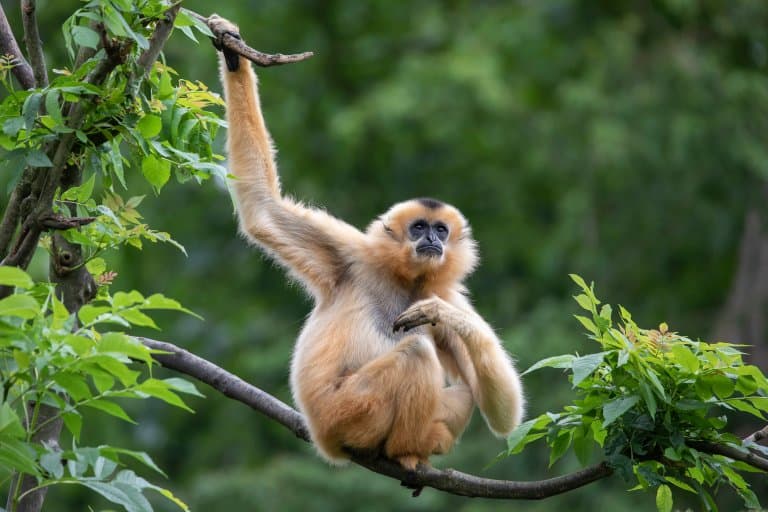
Gibbons are known as lesser apes, primarily by apes that can’t even hold their own bodyweight from a tree branch, let alone swing from it.
They’re Asian apes, a different branch from the so-called ‘greater apes’ but still large and without tails. There are 20 species of gibbon, and they’re all tree ninjas, some capable of swinging through trees at up to 55 km/h (34 mph), making them the fastest tree-dwelling, flightless animals.
Gibbon arms are so long, that they often have to be carried away from their bodies when walking bipedally, which looks suspiciously like they’re mocking us.
12. Poison Dart Frog (Dendrobatidae)
Back in the Americas, there are frogs so toxic they can be used to hunt monkeys. These diurnal frogs make no secret of their threat, they come in some of the most dazzling, contrasting colour patterns you’ll see in the jungle.
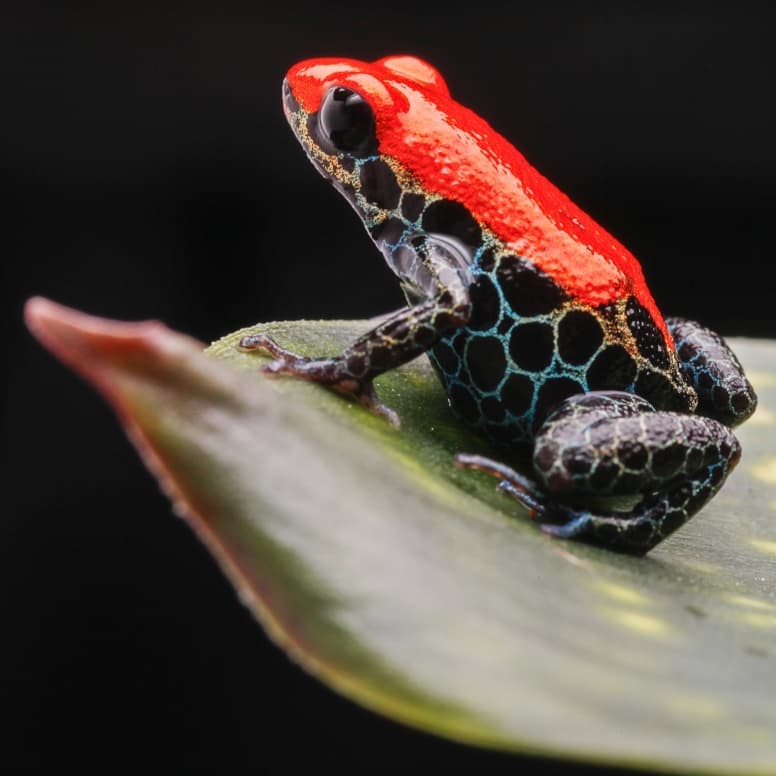
Arguably the most beautiful amphibians on the planet, they’re also some of the most deadly, and this has been used to the advantage of indigenous hunters, who use their secretions to coat the tips of blow darts and arrows.
The toxin they secrete actually comes from their natural diet, which means these frogs can be kept very safely in captivity, allowing owners all the benefit of the stunning colourations with none of the associated death.
There are over 170 species, most entirely unique in colouration, but only a handful are used in this manner. Many are threatened with habitat degradation and destruction, to which amphibians are particularly sensitive. 4
11. Orangutan
Another Asian ape, this time great in name as well as nature, is the ‘Old man of the forest”. Unlike the other great apes, these ones are almost entirely solitary and spend a lot of time looking philosophical up in the trees.
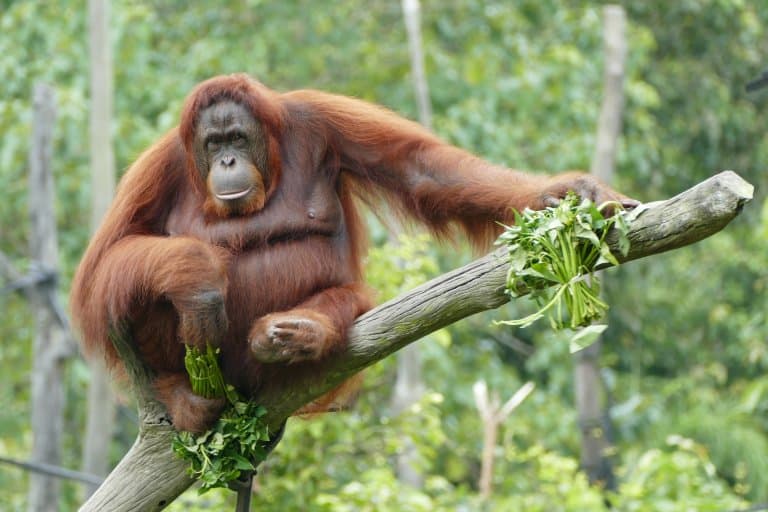
They’re also the heaviest tree-dwelling animal on Earth, reaching around the same weight as healthy humans, between 70kg and 90kg in males.
This adaptation to arboreal life likely came about as a result of another jungle animal on this list, which makes life very difficult for a large mammal on the ground.
Orangutans reproduce very slowly, giving birth at most once every five years, which, coupled with the intense deforestation pressure in their home ranges of Sumatra and Borneo, has resulted in a very endangered animal in all three of its species.
10. African Forest Elephant (Loxodonta cyclotis)
Back in Africa, there’s a jungle giant that mostly goes unnoticed. Everyone knows about the plains or bush elephants: Loxodonta africana, but the largest land animal has a very slightly less large forest-dwelling cousin, L. cyclotis.
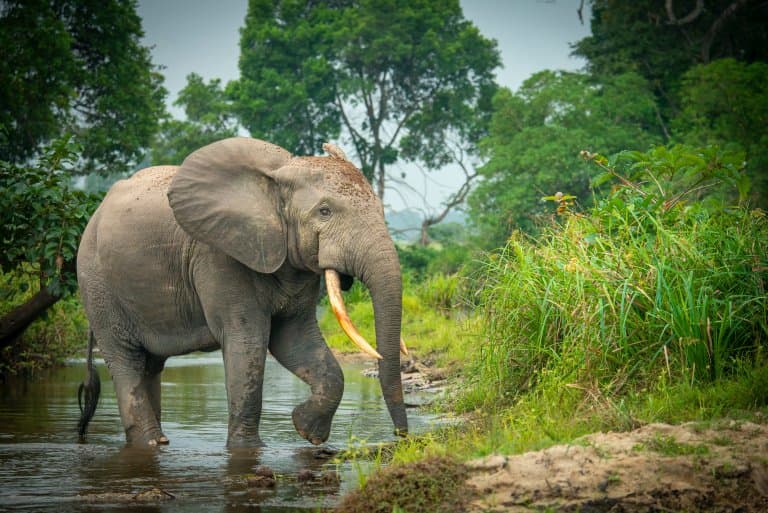
And this is a pity because the forest elephant is even more endangered than its famous cousin.
Forest elephants are certainly not small animals, at almost 3m tall but they can be told apart from their plains counterparts by the straightened tusks, which are presumably less likely to get tangled in dense jungle. Both females and males have them, and these can grow to around 1.5 meters long.
Of all the animals in the African jungle, these are some of the most dangerous. They are understandably grumpy around people, and while they’re generally shy animals, they do kill people who get too close.
They live in groups of up to around 20, are highly communicative, and as such enormous mammals are integral to the rainforest as seed dispersers and nutrient recyclers.
9. Sloth (Order: Pilosa)
It’s hard to think of sloths without letting out a sigh of lamentation for those who have gone before them. Giant ground sloths were some of the most awe-inspiring of the Pilosans, but not only are they dead, but they weren’t jungle animals, and lingering on them would be unfair to their extant relatives, who are exceptional in their own right.
In Central and Southern America hang some of the weirdest mammals in the jungle. Notoriously slow, sloths are no slouch, and can use their powerful claws to defend against pesky giant eagles and other jungle predators that might take their chances on one.

While the same jungle is home to hummingbirds, who have some of the fastest metabolisms of any animal and dart about manically on the hunt for high-calorie sugar fuel, sloths have taken the other extreme, cooling everything down and adapting to life in the slow lane.
They have a body temperature that humans would need urgent attention to remedy, they sleep for 20 hours a day and they eat low-quality roughage, but this doesn’t stop them from being excellent swimmers when they want to be.
They can also bite, hard, so don’t try to cuddle one.
Sloths move so slowly that their fur has become a biome of its own and is home to species of fly, beetle, mite, and algae that you may not find anywhere else.
8. Toucan (Family: Ramphastidae)
This must be the most recognisable jungle bird, and possibly well-known commercial mascot who you’d expect to speak with a nasal twang.
Toucans have outstanding noses, but to those who’ve met one they’re known to be playful and intelligent and the beak, which can be four times the size of its head, has long fascinated researchers.

While enormous, it’s surprisingly lightweight and appears to have a multitude of functions. The most obvious is as a grabber of fruit, the toucan’s preferred food. But it’s thought the bright colours help members of the species find one another in some of the most diverse bird habits on Earth, including 40 species of toucan!
These birds are highly social, and correspondingly noisy birds, who will rarely leave the forest canopy. While they mostly eat fruit, they’ll take the opportunity to peck at a bit of fish or insect too, when it arises.
Habitat loss and destruction have led to calls for their conservation, and many species are in decline, but most are still plentiful enough to be of least concern for now. 5
7. Green Tree Python (Morelia viridis) & Emerald Tree Boa, (Corallus caninus)
This one’s a double feature because it’s such an exceptional example of convergent evolution.
Sometimes, animals look similar because they come from the same ancestor. This is a run-of-the-mill example of evolution that we see all the time. But what gets naturalists going is when animals look similar because their environments are so similar.
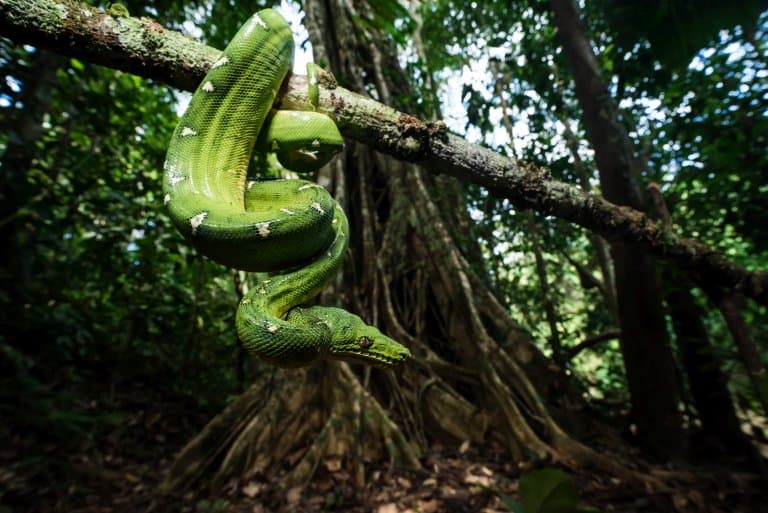
Species are carved out by their environments, so often, when two niches are identical, the organisms that fill them are equally similar.
In the case of the green tree python and the emerald tree boa, you have two snakes, separated by around 70 million years, who went down entirely different special paths. Pythons occupied Africa, Australia and Asia, while Boas are common on most continents but dominate in the Americas.
Both snakes are constrictors, both (in this example) are arboreal, and they’re both around the same size. Essentially, they fit the same ecological niche as one another, on entirely different continents.
The green tree python and the emerald tree boa are both stunning, vivid green snakes with white stripes for camouflage and vertical pupils, useful for gauging pouncing distance.
They’re both so similarly adapted that they even posture themselves on branches in the exact same way, with their head resting between two coils of their body. Both species even have remarkably similar lifespans, at around 20 years in captivity.
All of these features evolved not from a single ancestor, but independently, as a result of mutations that made the animals better suited to the environment. The result is a striking arboreal serpent. 6
6. Brazilian Wandering Spider (Phoneutria spp)
Wandering spiders are the reason to be afraid of spiders. These aggressive, highly venomous and often deadly creatures go against all the rationalisations you use to calm an arachnophobe.
Brazilian wandering spiders have four large front-facing eyes, which serve them well as an active hunter and their powerful venom is used to bring down large animals at night.
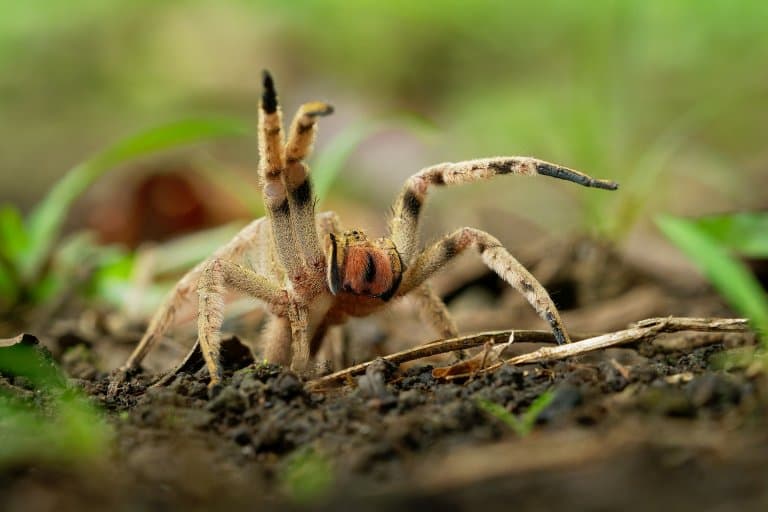
These species can have a leg span of around 15cm (6 inches) which is big enough to frighten a lot of people by sight, but they’re also known to be highly defensive, and confident in their ability to get you to go away.
There are a handful of species in the Phoneutria genus with the same common name, all with medically significant venom, and while they commonly eat insects like crickets and mantids, they’re able to bring down a bat, a frog or a lizard too, when they get the chance.
A bite from one of these spiders is known to cause prolonged erections, and not because it’s fun.
Priapism is a common side-effect of Phoneutria bites and can result in permanent damage or death of the penis if the owner survives the experience.
5. Black Caiman (Melanosuchus niger)
The crocodilian family Alligatoridae is home to two iconic subfamilies: the alligators and caiman, sometimes known as cayman.
Caimans are therefore more closely related to alligators than Crocs, though they tend to have narrower snouts. In general, they’re quite small as far as crocodilians go, but the black caiman, Melanosuchus niger can weigh up to a ton and sit ominously at 5m long on the banks of the forest rivers in Central South America.
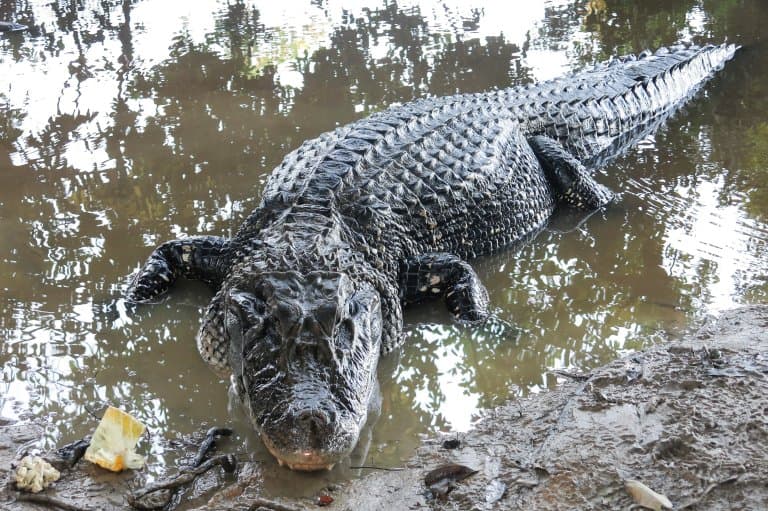
These are the largest of the Alligatoridae species and are powerful apex predators as a result. There aren’t many jungle animals big enough to escape the black caiman’s menu, but its skin has drawn the attention of human hunters, who have driven it to near extinction.
As a result, capybara and piranha populations boomed, and have threatened human crops and livestock, respectively.
The caiman also preys on people, occasionally, but not enough to really redress the balance. 7
4. Gorilla
You can’t make a jungle list without mentioning the gorilla. While chimps are our closest living relatives, gorillas are the ones we should aspire to be like.
These are the largest extant apes on Earth, yet they’re also one of the gentlest. A big example can weigh up to 250kg despite being no taller than an adult man, and maintain this exaggerated hypertrophy on a mostly vegan diet, supplemented with a few invertebrates, here and there.
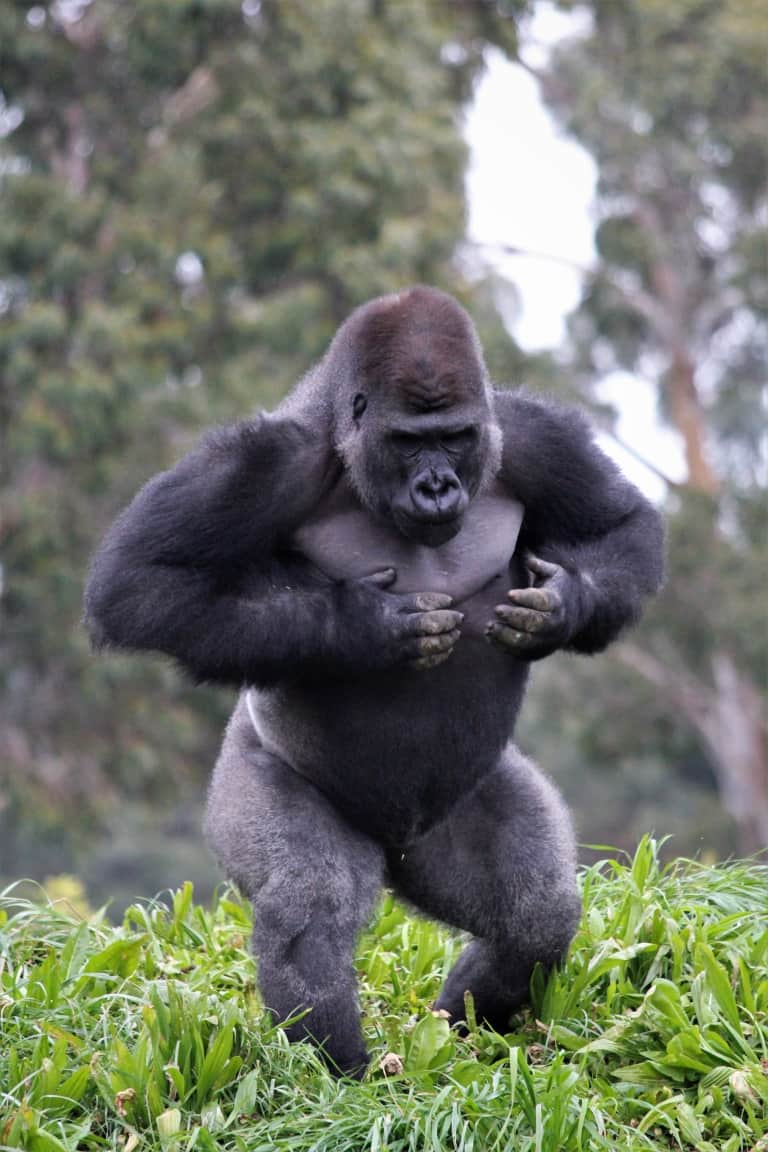
Only two species are remaining, both heavily protected in relatively limited ranges in equatorial Africa, and both are critically endangered.
Humans share around 99.9% of their DNA as a single species, but gorillas aren’t far behind, with around 98% of the same DNA (chimps have close to 99% similarity with humans).
Gorillas are highly social, intelligent and peaceful animals, with a lot of muscle to back up their ideas when they are pushed to. There don’t appear to be any confirmed examples of a gorilla killing a human, either in the wild or in captivity. 8
3. Jaguar (Panthera onca)
The largest jungle cat in the Americas has to sit close to the top of the list of iconic rainforest animals. Jaguars are about the only thing that will scare a black caiman, and as the third-largest cat in the wild, it’s at the top of the food chain.
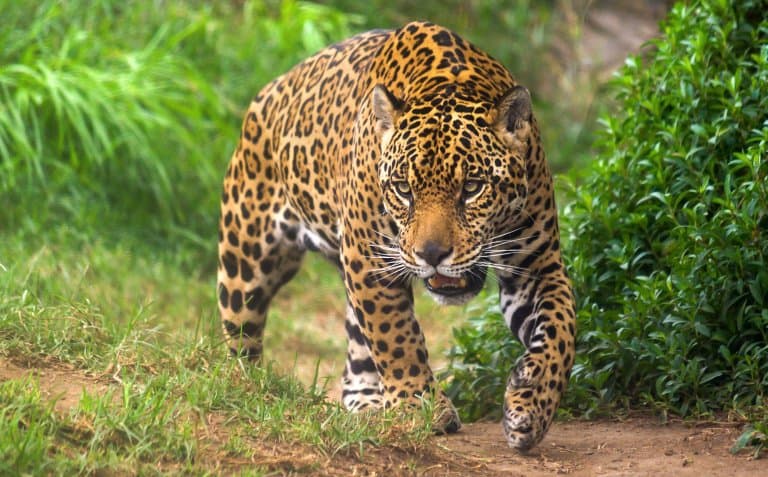
Jaguars are specialist biters, with one of the most powerful clamps in the animal kingdom. Their piercing teeth have evolved to puncture turtle shells and the skulls of caiman and other poor victims, who never see this expert stalker coming.
Unlike most cats, jaguars love the water, and this is what makes them such a significant forest species. Jaguars can hunt on almost any terrain, and while it is an obligate carnivore, it has a huge range of prey species and is therefore critically important as population control within its ecosystem.
Jaguars will predate upon all of the South American animals on this list and have played a symbolic role in human societies as an icon of strength and grace since prehistoric times.
2. Piranha (Family: Serrasalmidae)
After the great white shark, this might be the most feared fish in the water.
Piranhas are the Bond villain’s execution method of choice, and yet another example of Christopher Lloyd’s strange sense of humour as the antagonists of Piranha 3DD.

They’re clearly solidified in the public opinion as mindless, swarming murderers, but this isn’t a fair representation.
There are four genera of true piranhas, with between 30 and 60 species, perhaps more, all indigenous to the Amazon basin. They’re well known for their huge, sharp teeth and a bite force that is one of the most powerful of all bony fishes. Pound for pound, this bite is one of the strongest of all vertebrates!
Their reputation for hunting in huge packs and stripping the meat off of anything unlucky enough to show its face is only partially true. In general, they are omnivorous and will eat meat opportunistically.
They don’t tend to school in high densities except in times of drought, and attacks on people are extremely rare. The vast majority of reported attacks come from a single fish biting the toe or hand of a swimmer, but there are freak occurrences where people have died.
Piranhas are more likely to feed on the decaying flesh of drowning victims than kill their own human food, but records from Teddy Roosevelt’s trips through the Amazon basin lend credence to the idea that they can be agitated into a feeding frenzy under certain conditions and that the local peoples wade through piranha territory with great care!
1. Tiger (Panthera tigris)
Most of this list is populated in no particular order, but it should go without saying that the most iconic jungle animal in the world is the tiger.
The largest wild cat on Earth, and a supremely successful apex predator that’s had a long and troublesome history of life alongside human settlers to their continents.
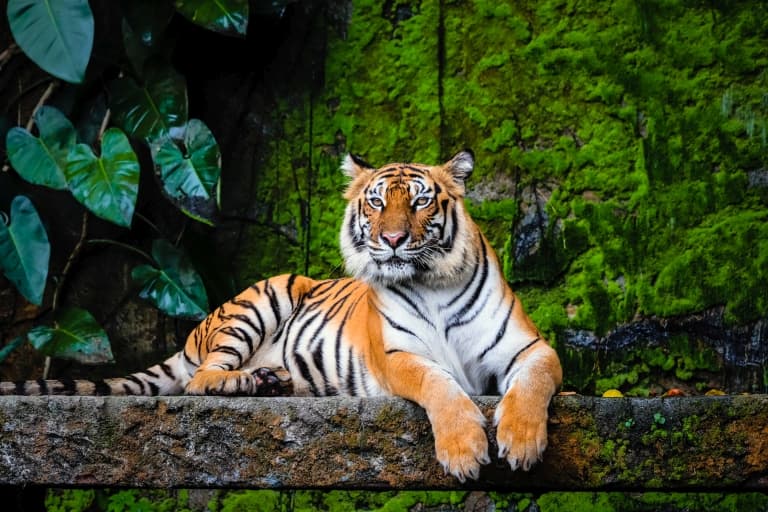
It’s tigers who are likely responsible for the arboreal nature of orangutans. It’s tigers who, even to this day, hold up the veracity of jungle monster legends with their hundreds of human kills per year in India alone.
And they do this despite being truly decimated by human hunting and habitat destruction.
Tigers are phenomenally agile animals, camouflaged giants who can leap ten meters and run at up to 65 km/h. They are solitary, graceful and immensely powerful and there’s nothing in the jungle that really comes close to their awe-inspiring presence.
Like the jaguar, the tiger is adept at swimming – something which is extremely common in jungle-adapted species.
Such enormous predators are critically impactful on their ecosystems, recycling nutrients and keeping large herbivore populations under control. Sadly, competition with domestic livestock and the fact that they’re revered as terrible monsters by locals has led to their persecution as dangerous animals.
But the destruction of the rainforests in which they live plays a far larger role in their decline. Tigers are now endangered and in desperate need of protection. 9
Final Thoughts
Jungles are about the most biodiverse regions of land on Earth, and as such we could populate a list like this, each filled only with arthropods, or fish, or birds, amphibians, reptiles or mammals. Even choosing 20 of the most interesting parasites from the jungle would be difficult.
There is so much life to explore, and while they hold some of the most known species, the jungles are also home to more species that we don’t yet know.
It’s thought that tropical forests house 80% of the yet-to-be-discovered species on land, many of which are going extinct in silence, never to be recorded and witnessed by humans. 10
But it doesn’t have to be this way. Rainforest protection is something we can all get involved with, whether we live nearby or not.
And while it’s important to our species that we protect jungles for their benefit us, it’s also important to remember that without them, the thousands of iconic jungle animals have nowhere to go.
Fact Sources & References
- “Tapirs“, National Geographic.
- Avianne Tan (2016), “Capybaras, Giant Rodents Native to South America, Could Become Invasive Species in Florida“, ABC News.
- “Macaw“, San Diego Zoo.
- Frank Indiviglio (2010), “Poison Frog Skin Toxins and Their Use in Hunting and Warfare“, That Reptile Blog.
- “Toucan“, San Diego Zoo.
- Stephen Luntz (2016), “Pythons And Boas Evolved In Parallel“, IFL Science.
- “Black Caiman“, Crocodiles of the World.
- Dave Mosher (2012), “Gorillas More Related to People Than Thought, Genome Says“, National Geographic.
- “Tiger conservation success in 2023“, ZSL.
- Elizabeth Claire Alberts (2021), “New map shows where the 80% of species we don’t know about may be hiding“, Mongabay.
